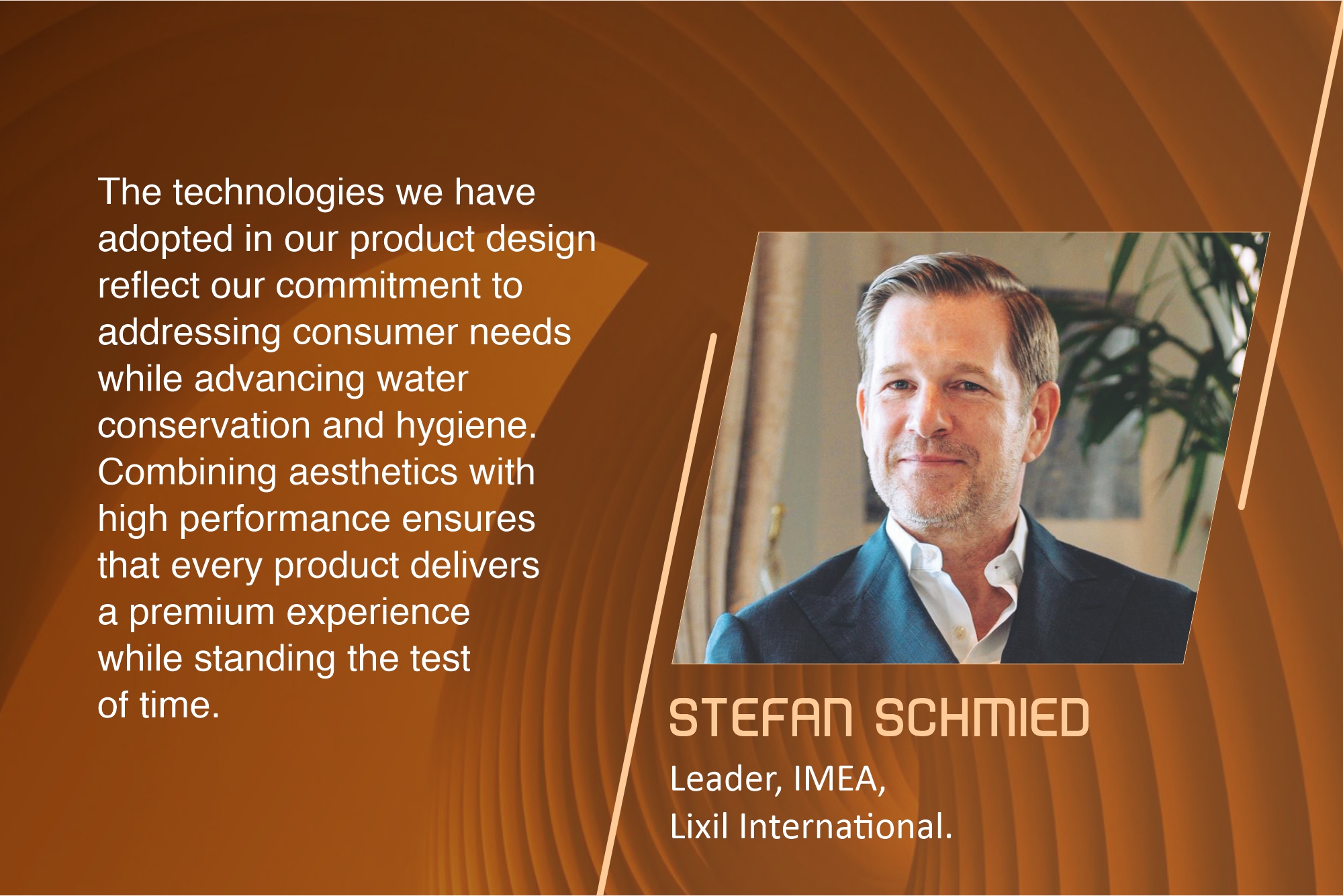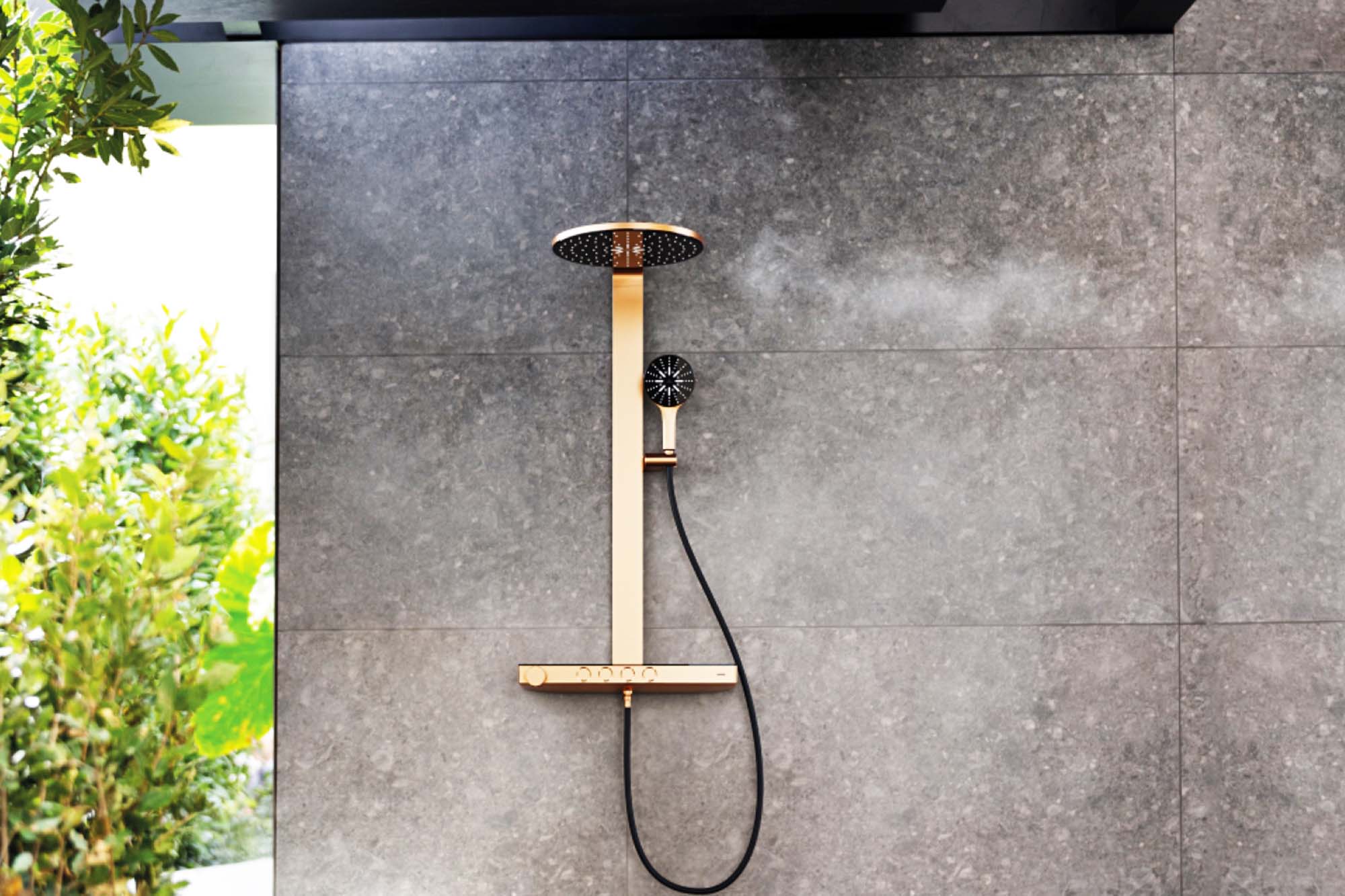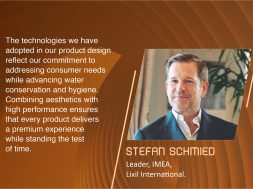PURE FREUDE AN WASSER

In this interaction, Stefan Schmied elucidates GROHE’s design philosophy for bath and kitchen products for the Indian and Middle East markets. He delves into how GROHE is leveraging technology to produce designs that are not only functional but also aesthetically pleasing and hygienic.
How is technology influencing bath and kitchen designs? Can you elaborate on the technologies that GROHE uses for its bath and kitchen products?
Technology has transformed bathrooms and kitchens from purely functional spaces to highly personalised environments that offer comfort, convenience, and wellness. Some technologies we leverage at GROHE, brand part of LIXIL, include GROHE SmartControl, GROHE Blue, GROHE Everstream, and GROHE Red. GROHE SmartControl allows users to control water flow and temperature precisely using a push-and-turn mechanism. GROHE Blue is for kitchens, which offers filtered still, medium, and sparkling water straight from the tap, an innovation that supports both convenience and sustainability. GROHE Everstream is one of our latest innovations, significantly reducing water consumption. It consists of a water-recirculating shower that reuses and purifies water during a single shower session. GROHE Red is for kitchen applications; it delivers instant boiling water, combining safety and efficiency.
Can you talk about how you evolved with the “7 degree” concept in your faucet designs?
The “7-degree” forward-leaning design of our faucets is a hallmark of GROHE’s ergonomic approach to product development. Originally inspired by how users naturally interact with bathroom fittings, the concept was introduced to ensure better visibility, comfort, and usability during daily routines. The design emerged from consumer insights and rigorous testing, balancing form and function. The slight tilt provides easier access and a more intuitive user experience without compromising aesthetics. The design reflects a modern style and enhances hygiene because water splashes are minimised, and users can interact with the faucet more naturally.

We see more vibrant colour choices in Asian markets, whereas the European market prefers earthy colours. How do you assess whether these choices and preferences affect the product range designs? Do you customise according to the markets?
At GROHE, we go by the fact that cultural and regional preferences deeply influence design. In Asian markets, especially in India and Southeast Asia, consumers often embrace bold, vibrant finishes such as Cool Sunrise (gold) or Warm Sunset (copper), which reflect a taste for luxury and personalisation. In contrast, European markets favour subtle, matte finishes like Brushed Nickel or SuperSteel, which are aligned with minimalist design trends. We continuously monitor these preferences through market insights and local design research. Our product range includes the GROHE Colors Collection, which offers a wide palette of finishes to match local aesthetic preferences. This flexibility allows us to customise offerings while maintaining our global design language.
With almost every sector being driven by factors such as the growing demand for eco-friendly and sustainable options, bath and kitchen products is no exception. How are these factors and the increasing focus on hygiene and cleanliness being considered during your design and production process?
Sustainability and hygiene are at the core of GROHE’s design philosophy. GROHE EcoJoy is a standout eco-friendly technology which reduces water usage without compromising performance. Additionally, our infrared touchless faucets improve hygiene by minimising physical contact, which is becoming more popular in public and residential spaces. Our production facilities are carefully designed to be resource-efficient, with several plants achieving CO2-neutral production. We also take pride in GROHE being the first in the sanitary industry to receive Cradle-to-Cradle certifications for several of its products, ensuring they can be reused at the end of their lifecycle rather than becoming waste.

How are your products tested for quality and safety, and what standards or certifications must they meet? Do these standards vary for the Indian and MEA regions?
Our products undergo rigorous in-house testing at our state-of-the-art laboratories in Germany. Each product is tested for durability, safety, water efficiency, and material compliance before release. We ensure that our products comply with international standards such as WRAS (UK), DIN, KIWA (Netherlands), and NSF (USA), depending on the market requirements. For India and MEA regions, while the core product quality remains consistent with our internal standards, we adapt to local certification needs and installation environments. For example, we follow BIS standards in India, G-Mark certification in Gulf countries, and SASO in Saudi Arabia. Additionally, our initiative as the first international player to manufacture concealed cisterns in Saudi Arabia and products under the “Make in India” programme is a testimony to our dedication to embracing the regional labour force without compromising global quality standards.
What materials are used in manufacturing your products, and how are they selected to balance durability, aesthetics, and functionality?
Brass and zinc, with chromed finish or advanced PVD coatings, are our primary raw materials. We choose these materials to achieve an ideal balance of durability, hygiene, safety, and visual appeal. Our GROHE StarLight® chrome finish, for instance, ensures long-lasting shine and resistance to tarnishing and scratches. GROHE Zero is a technology developed by GROHE that ensures drinking water is 100 percent lead- and nickel-free. It is used in selected kitchen faucets and GROHE Blue water systems, and involves a special inner waterway that isolates the water flow from any contact with metal parts that might release trace elements into the water.
What factors do you consider while designing products for the Indian market?
India is a highly diverse and dynamic market, so our design philosophy prioritises reflecting a mix of cultural relevance, functionality, and environmental considerations. Key factors that influence design include high water pressure variability, which requires robust internal components; preference for durable, easy-to-clean finishes to cater to the diverse climatic and usage conditions; increased demand for hygiene-enhancing features, such as touchless technology and self-cleaning nozzles; and the importance of value-driven luxury, where customers seek world-class design and functionality at accessible price points. We also work closely with local partners, architects, and designers to better understand evolving consumer behaviour and continuously enhance and customise our product offerings.
For more detals, visit: https://www.grohe.co.in/en_in/
Cookie Consent
We use cookies to personalize your experience. By continuing to visit this website you agree to our Terms & Conditions, Privacy Policy and Cookie Policy.










